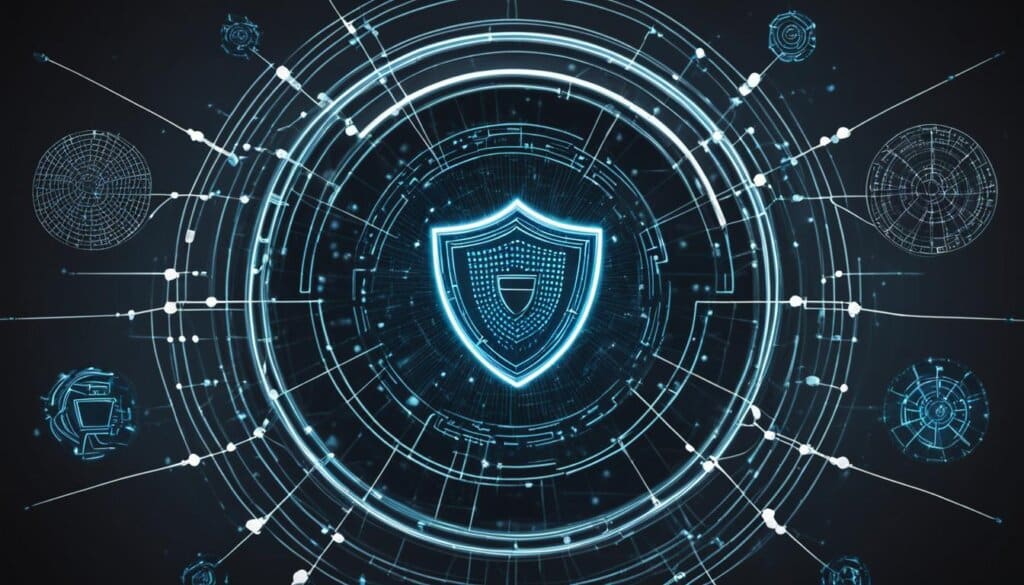Table of Contents
Cybersecurity essentials are crucial for protecting digital information in today’s interconnected world. As our reliance on technology continues to grow, it becomes increasingly important to prioritize cybersecurity practices to safeguard our online presence.
Cyber threats can compromise the confidentiality, integrity, and availability of data, posing significant risks to individuals and organizations. That’s why understanding the importance of cybersecurity and implementing effective strategies is of utmost importance.
The Cyber Essentials guide by CISA (Cybersecurity and Infrastructure Security Agency) provides actionable steps for small businesses and government agencies to develop a culture of cyber readiness. This comprehensive guide outlines essential practices to protect digital information, including:
- Leadership involvement in driving cybersecurity strategies and investments
- Providing basic cybersecurity training for staff members
- Protecting critical assets and applications
- Securing digital workplaces
- Implementing data protection measures and incident response planning
To illustrate the significance of cybersecurity essentials, let’s delve deeper into each of these areas and explore the practical steps that individuals and organizations can take to protect their digital assets.
Building a Culture of Cyber Readiness
A culture of cyber readiness is essential for effectively managing cyber risks and ensuring the security of valuable digital assets. In today’s interconnected world, leaders play a pivotal role in driving cybersecurity strategy, investment, and culture within their organizations.
Investing in basic cybersecurity measures is a key responsibility for leaders. By allocating resources to cybersecurity, organizations can proactively protect themselves against potential threats and vulnerabilities. This investment includes implementing robust security protocols, leveraging advanced technologies, and staying updated on emerging cyber risks.
It is crucial for leaders to assess their organization’s dependence on IT. By understanding the role of technology in their operations, leaders can identify potential cyber risks and develop effective risk management strategies. This includes evaluating the security of critical systems, applications, and data, as well as identifying areas that may require additional protection.
Establishing trusted relationships with sector partners and government agencies is another crucial aspect of building a culture of cyber readiness. These partnerships provide valuable insights and information on emerging cyber threats, enabling organizations to strengthen their defenses and respond effectively to potential incidents. Collaboration with external stakeholders is essential for staying informed about the latest cybersecurity trends and best practices.
In consultation with IT, leaders should actively lead the development of cybersecurity policies and ensure their effective implementation. By establishing clear guidelines and best practices, organizations can establish a strong cybersecurity framework that protects their digital assets and minimizes the risk of cyber attacks.
Cybersecurity should be viewed as a business risk rather than solely an IT issue. Leaders must recognize that the consequences of a cyber attack extend beyond technical disruptions and can have a significant impact on an organization’s reputation, financial stability, and customer trust. By approaching cybersecurity as a strategic business priority, leaders can prioritize resources, implement proactive measures, and align cybersecurity efforts with the organization’s overall objectives.
Building a culture of cyber readiness requires a collective effort, involving all members of the organization. By fostering a cybersecurity-conscious culture and providing ongoing training and awareness programs, leaders can ensure that employees are equipped with the knowledge and skills necessary to identify and respond to potential cyber threats.
Image:
Developing Cybersecurity Awareness and Vigilance
Staff members are vital components of a culture of cyber readiness. It is crucial to educate them about cybersecurity awareness to make informed decisions while navigating the online world. By being aware of common risks such as phishing and business email compromise, they can contribute to maintaining a secure digital environment. Staying up to date on cybersecurity trends and events is also important to stay ahead of emerging threats.
To enhance their cybersecurity knowledge, staff members should have access to comprehensive cybersecurity training resources. This includes training programs offered by professional associations, academic institutions, the private sector, and government sources. Collaboration between leaders and IT departments plays a pivotal role in leveraging these resources effectively.
Leaders and IT professionals should work together to identify the most suitable cybersecurity training resources for their staff. These resources should cover a range of topics, from basic cybersecurity practices to more advanced techniques. By providing staff members with the necessary training, organizations can empower them to make informed decisions and actively contribute to maintaining a culture of cyber readiness.
By developing cybersecurity awareness and vigilance among staff members, organizations can significantly strengthen their overall cybersecurity posture. Continuous training and education will ensure that employees have the knowledge and skills to recognize and respond to cyber threats, ultimately enhancing the resilience of the organization as a whole.
Protecting Critical Assets and Applications
Systems and applications are the backbone of an organization, ensuring its operational efficiency. Therefore, protecting these assets is of paramount importance. Leaders need to take proactive measures to safeguard systems and networks from potential threats.
Understanding Your Network
First and foremost, it is crucial for leaders to have a thorough understanding of their network. This involves identifying all connected devices, including hardware and software assets, to maintain accurate inventories. By knowing what is on their network, leaders can effectively assess security risks and make informed decisions to protect critical assets.
Implementing Security Configurations
Once the network is understood, leaders should focus on implementing robust security configurations. This involves applying industry best practices and recommended security settings to all assets. By doing so, leaders can establish strong defenses against potential breaches and vulnerabilities.
Removing Unauthorized Hardware and Software
To maintain a secure network, leaders must ensure that all hardware and software used within the organization are authorized and supported. This includes regularly reviewing and removing any unsupported or unauthorized devices or applications. By doing this, leaders can minimize potential security risks and maintain control over their network environment.
Email and Web Browser Security Settings
Email and web browsers are common entry points for cyber attacks. To protect against malicious emails and unsecured web pages, leaders should leverage robust email and web browser security settings. This includes enabling spam filters, implementing strong authentication methods, and regularly updating security patches.

Implementing these security measures helps create a fortified defense system for critical assets and applications, reducing the risk of unauthorized access and potential data breaches.
Ensuring Secure Digital Workplaces
The digital workplace is an essential component of a culture of cyber readiness. To protect sensitive information and reduce the risk of unauthorized access, leaders should implement the following measures:
- Maintain network inventories to track all connections and devices.
- Enforce multi-factor authentication for user accounts, adding an extra layer of security.
- Grant access and administrative permissions based on the principle of least privilege access, ensuring that users only have the privileges required for their roles.
- Require the use of unique passwords for user accounts to prevent password reuse and enhance security.
- Establish comprehensive IT policies and procedures to govern user status changes, ensuring that access rights are revoked when necessary.
Implementing these measures helps to create a secure digital workplace where only authorized individuals have access and reduces the risk of unauthorized entry.
Data Protection and Crisis Response
Data is a vital asset for any organization, and protecting it is essential for a culture of cyber readiness. Leaders need to understand how their data is protected and take proactive measures to ensure its safety. This includes maintaining inventories of critical or sensitive information, implementing network and perimeter monitoring, and establishing regular automated backups of key systems.
Additionally, leveraging malware protection capabilities is crucial to safeguard against potential threats. By having effective incident response and disaster recovery plans in place, leaders can minimize the impact of cyber incidents and restore normal operations quickly.
Furthermore, leaders should take the lead in developing internal reporting structures and in-house containment measures. This enables organizations to promptly identify and address any breaches or vulnerabilities, limiting their impact and preventing further damage. By prioritizing data protection and crisis response, leaders can establish a secure and resilient cyber environment for their organizations.
FAQ
What is Cybersecurity Essentials?
Cybersecurity Essentials is the practice of protecting digital information from threats that can compromise the confidentiality, integrity, and availability of data. It involves implementing cybersecurity practices to safeguard online presence.
Why is cybersecurity important?
Cybersecurity is important for individuals and organizations to protect their digital information from threats. It helps prevent unauthorized access, data breaches, and other cyber attacks that could lead to significant financial and reputational damage.
How can I build a culture of cyber readiness?
Building a culture of cyber readiness involves leadership involvement in cybersecurity strategy and investment. It includes basic cybersecurity training for staff, protection of critical assets and applications, securing the digital workplace, data backup strategies, and incident response planning.
How can I develop cybersecurity awareness and vigilance?
You can develop cybersecurity awareness and vigilance by educating staff members about common risks like phishing and business email compromise. Staying updated on cybersecurity trends, accessing available training resources, and collaborating with IT to identify training opportunities are also important.
How can I protect critical assets and applications?
To protect critical assets and applications, leaders should take action by maintaining inventories of hardware and software assets, implementing security configurations, removing unsupported or unauthorized hardware and software, leveraging email and web browser security settings, and establishing application integrity policies.
How can I ensure a secure digital workplace?
You can ensure a secure digital workplace by maintaining inventories of network connections, leveraging multi-factor authentication for users, granting access and admin permissions based on need-to-know and least privilege, using unique passwords for user accounts, and establishing IT policies and procedures for changes in user status.
How can I protect data and respond to cyber incidents?
To protect data, leaders should learn how their data is protected, maintain inventories of critical or sensitive information, and implement network and perimeter monitoring. Regular automated backups of key systems, leveraging malware protection capabilities, and having incident response and disaster recovery plans in place are also crucial. Developing internal reporting structures and containment measures will help limit the impact of cyber incidents and restore normal operations quickly.







